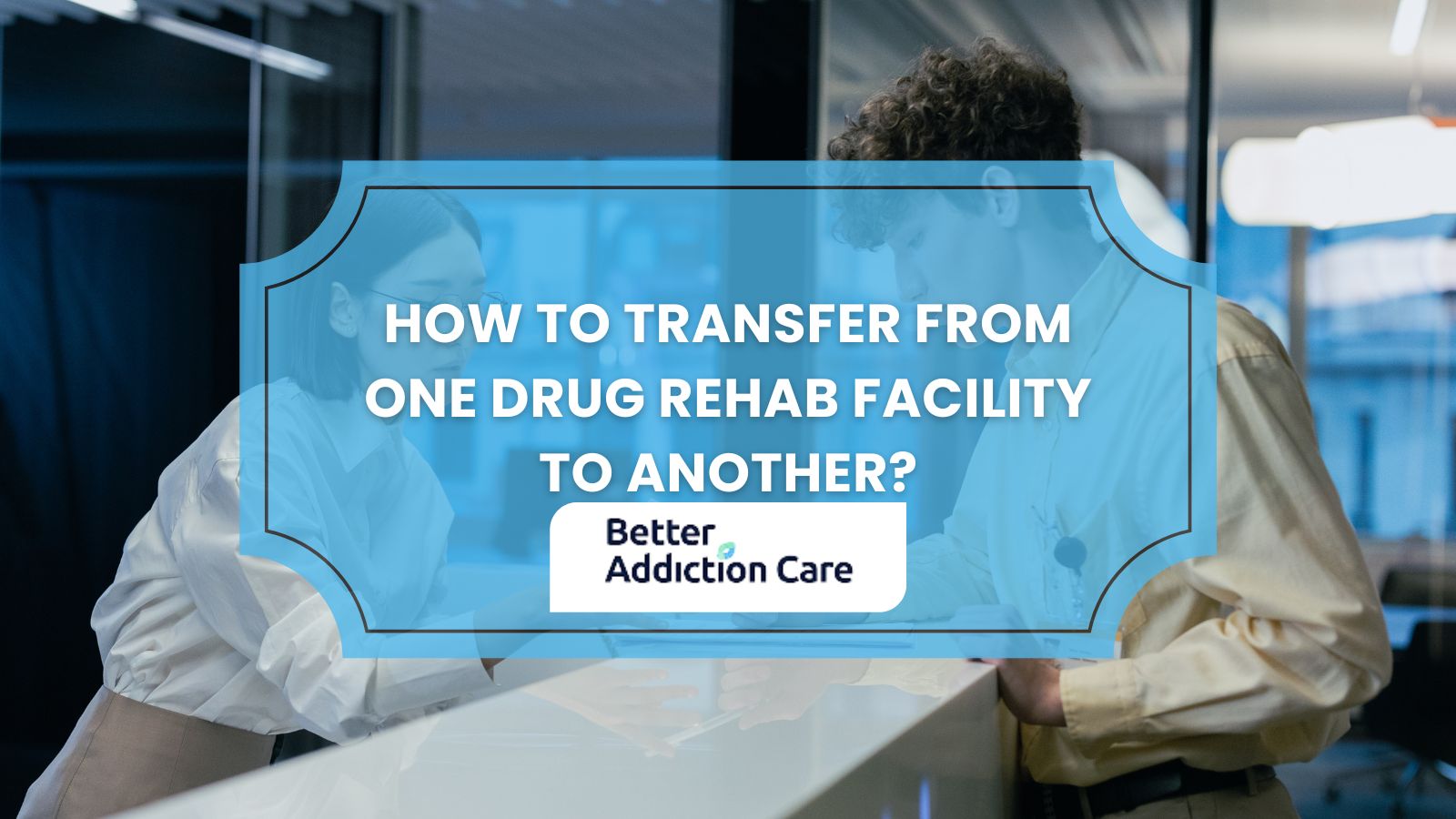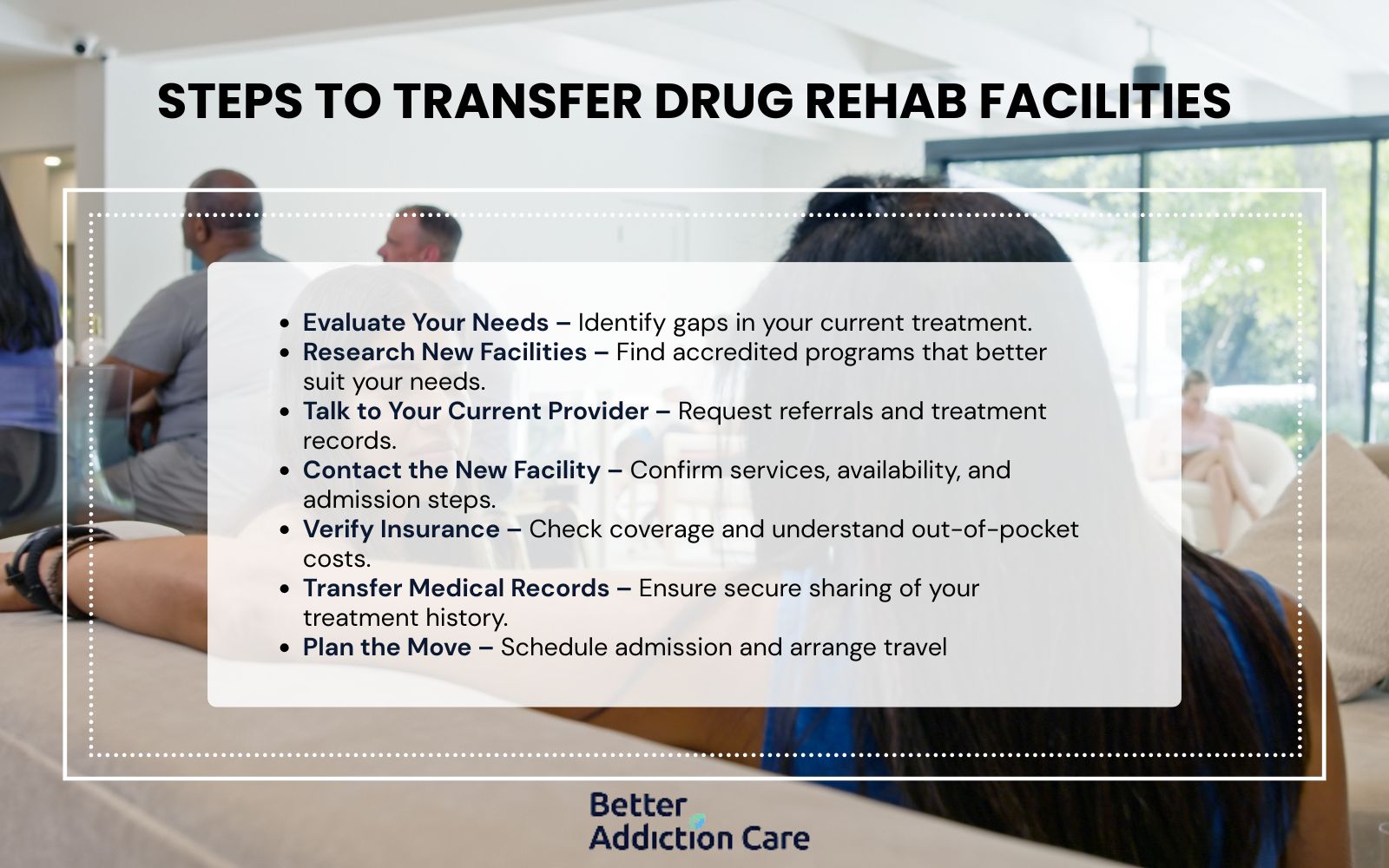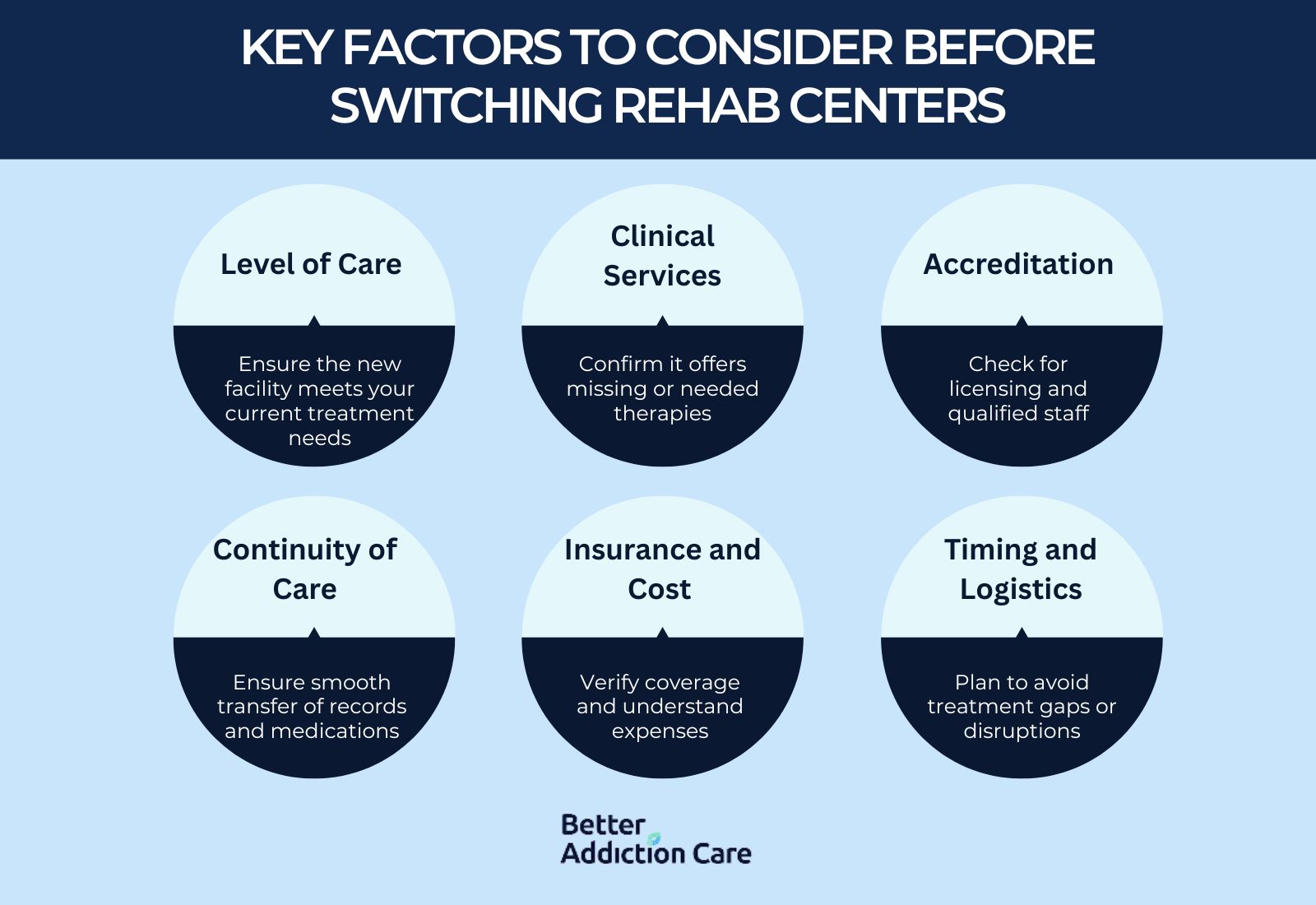How to Transfer from One Drug Rehab Facility to Another?
Starting addiction treatment is a brave decision, but what happens when the program you chose doesn’t meet your needs? Whether it’s due to a lack of progress, an uncomfortable environment, or missing resources, many individuals find themselves wondering how to transfer from one drug rehab facility to another.

The good news is: you’re not stuck. Making the choice to switch rehab centers is not a setback, it’s a step toward a more personalized and effective recovery. According to the 2022 Treatment Episode Data Set (TEDS) from SAMHSA, 21.0% of all discharges from substance use treatment were transfers to further treatment. This means about one in five individuals leaving a rehab program are formally transferred to another level of care or a different facility for continued treatment
Every journey is different, and sometimes changing addiction treatment programs is necessary to get the care that truly supports your growth. With proper rehab transition support, the process of transferring to a new facility should be smooth and empowering.
You deserve a treatment plan that aligns with your goals, respects your voice, and gives you real hope for lasting sobriety. Transferring to the right program reignites your recovery and moves you closer to the life you’re fighting for.
How Do I Transfer Drug Rehab Facilities?

Transferring from one drug rehab facility to another is a straightforward process, especially when you know what to expect and have the right support. Whether you're seeking a better fit, a higher level of care, or a new environment, switching programs helps reinvigorate your recovery journey. The key is communication, talking with your current treatment team and potential new facility to coordinate care and ensure a seamless transition.
Steps to Transfer Drug Rehab Facilities:
-
Evaluate Your Needs: Identify what’s missing or not working in your current program (e.g., lack of mental health support, environment, treatment style).
-
Research New Facilities: Look for accredited programs that offer the services and level of care you need.
-
Speak with Your Current Provider: Discuss your desire to transfer and ask for records or referrals.
-
Contact the New Facility: Confirm availability, treatment options, and admission requirements.
-
Verify Insurance Coverage: Ensure your policy covers treatment at the new location and understand any costs.
-
Request Medical Records Transfer: Coordinate the safe, confidential transfer of your treatment history.
-
Plan the Transition: Schedule your admission and arrange transportation or travel if needed.
Why Would Someone Switch Drug Rehab Centers?

There are many valid reasons a person might choose to leave one rehab facility and continue their recovery elsewhere including lack of progress or a desire for more specialized care, making the move to a new facility significantly improves your recovery outcomes.
Common reasons for transferring rehab facilities:
-
Incompatible Treatment Approach: The current program does not align with your recovery philosophy, such as offering 12-step when you prefer a holistic or non-12-step model.
-
Lack of Progress: If you’re not seeing results or feel stuck, a new environment or care team will help you re-engage.
-
Co-Occurring Disorders Not Addressed: Some facilities lack the expertise or resources to treat underlying mental health conditions alongside addiction.
-
Specialized Services Needed: You require trauma therapy, dual diagnosis care, or medication-assisted treatment not offered at your current facility.
-
Location or Family Considerations: Being closer to home, or farther away for privacy, influences your ability to stay committed to treatment.
-
Comfort and Safety: If you feel unsafe, unsupported, or uncomfortable, transferring provides a healthier space to heal.
Why Would Someone Transfer Rehab Facilities After Completing a Level of Care?

Someone would transfer to different facilities if the current rehab they are attending doesn’t offer the level of care that they need. As individuals complete one phase of treatment, such as medical detox or residential care, they frequently transition to a different facility for the next level, like partial hospitalization (PHP) or intensive outpatient (IOP). These transfers are part of a stepped approach to recovery that ensures the right level of care is provided at the right time.
Common examples of level-based transfers include:
Detox to Residential Treatment
Once medically stabilized, clients leave detox and enter a residential program for continued support and therapy. According to the National Institute on Drug Abuse (NIDA), without subsequent treatment, individuals are at a high risk of relapse. NIDA reports that approximately 40-60% of individuals relapse after treatment thus showing the need for higher levels of care.
Residential Inpatient to PHP
After 24/7 care, clients will move to a structured day program or partial hospitalization program that allows for increased independence. 65% of clients in residential programs completed treatment, compared to 52% in outpatient settings, based on a national sample of publicly funded programs according to Staher, G. et. al “Residential and outpatient treatment completion for substance use disorders in the U.S.: Moderation analysis by demographics and drug of choice”.
PHP to IOP
As progress continues, individuals step down to intensive outpatient treatment with a few sessions per week while resuming work, school, or family responsibilities. Less than one-third of individuals relapsed to alcohol use at the one-month follow-up after completing a PHP for alcohol treatment, according to a clinical study according to Blevins, C. et. al. “Alcohol treatment outcomes following discharge from a partial hospital program”. This shows the need for additional therapy and treatment after PHP.
IOP to Outpatient Therapy
For those nearing the end of formal intensive outpatient treatment, outpatient counseling provides ongoing support while reintegrating fully into daily life. Outpatient treatment accounted for 84.6% of all substance use disorder treatment admissions in the United States according to the Recovery Research Institute.
What Should You Consider Before Changing Rehab Facilities?

Before making the decision to transfer from one rehab center to another, it’s important to evaluate the reasons behind the move and ensure that the transition will truly support your recovery. Planning ahead helps ensure the move strengthens your progress rather than disrupting it.
Key factors to consider before switching rehab centers:
-
Level of Care: Does the new facility offer the same or a more appropriate level of care (e.g., inpatient, PHP, IOP)?
-
Clinical Services: Make sure the new program provides therapies or treatments that were missing in your previous center.
-
Accreditation and Credentials: Verify that the new facility is licensed and staffed by qualified professionals.
-
Continuity of Care: Consider how your records, progress, and medications will be transferred without interruption.
-
Insurance and Cost: Check if your insurance covers the new program and clarify any out-of-pocket costs.
-
Timing and Logistics: Plan your transfer carefully to avoid gaps in treatment or emotional setbacks during the move.
How to Find a Treatment Center or Rehab near Me?
To find the right rehab or treatment center near you there are trusted resources that make the process easier and more accessible. One of the most effective tools is an online rehab locator, such as the one offered by Better Addiction Care. These platforms allow you to search by location, level of care, treatment specialty, and insurance provider. With just a few clicks, you compare facilities, read about available services, and contact admissions teams directly to ask questions or verify coverage.
You should also speak with your primary care doctor, therapist, or insurance provider for referrals. The key is to find a center that is licensed, evidence-based, and aligned with your recovery goals, so you feel supported every step of the way.
Can I transfer rehab centers in the middle of a program?
Yes, you can transfer at any point during treatment if your current program isn’t meeting your needs. With proper planning and communication between both facilities, the transition is made smoothly without interrupting your progress.
Will my insurance cover a transfer to a different rehab facility?
Yes, especially if the new facility is in-network and the transfer is deemed medically necessary. It’s important to verify coverage with your provider and have the new center perform a benefits check.
Do I need a referral to switch rehab programs?
Not always. While a referral from your current treatment team is helpful for continuity of care, you are able to reach out directly to a new facility and begin the admissions process independently if needed.
What happens to my treatment records when I transfer?
Your treatment records are securely transferred to the new facility with your written consent. This allows the new care team to understand your history and continue building on your progress.
Related Articles
Treatment Centers in Virginia







